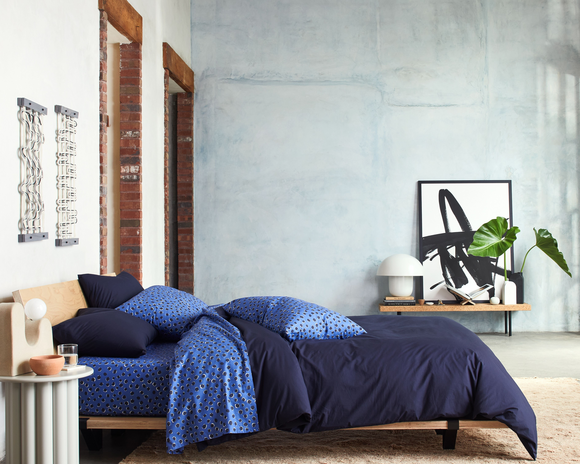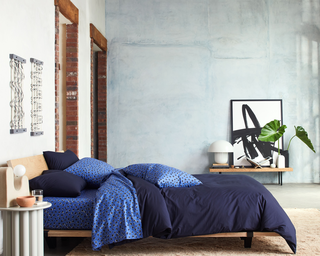After days, or possibly weeks, of searching through off-campus dorms or first apartments for one you could see yourself calling home, you’ve finally found your dream space! The hard part is over, right?
Wrong.
If you don’t act soon, move-in day will come and you won’t have a bed to sleep in or a plate to eat your toast on — your apartment is unfurnished. With so much to buy and so many rooms to decorate, the process can seem overwhelming at first, but here are six simple tips to keep you on track while tackling the monumental task of furnishing your first apartment.
- Visualize your ideal home
-
When looking at an empty apartment, it can be difficult to imagine what it’d actually look like furnished. How you decorate a room can fundamentally change how it looks and feels — you can either make the space feel bigger and cozier or smaller and more cramped, depending on what you choose. To find the style that you like, I recommend hitting up Pinterest, and the Tik Tok tags #apartmenttour and #organizationhacks for inspiration, then getting your room measurements from your landlord to start planning.
Come up with a colour scheme for each room to reflect the kind of vibe you want in each space. As a guide, warmer colours are vibrant and inviting, and work well in social spaces. Cooler colors are more calming and relaxing. If you’re attempting to make a studio look bigger, light colors will be your best friend, while darker colors may make a bedroom feel extra cozy.
- Make a list of everything you need
-
This may seem obvious, but you’d be surprised how many bits and bobs you need to fully furnish an apartment; from a soap tray to extra coat hangers to salt and pepper shakers, you’re bound to forget something. It’s good to make a list of everything that’s essential first, so you don’t get carried away, and then you can consider what kind of extra decor you might want to add.
I like to break my list down room by room, which helps you visualize how you’d like to use each space. For example, do you want your desk in your bedroom or the living room? What matters more to you, a big table for playing board games with friends or a cozy couch-tv-cave for Netflix or video games? You can decide where you want things to go, and what furniture you need for each area of your apartment by making those evaluations.
- Make a budget
-
Now you know what items you’re looking for, it’s time to consider the budget. This step is important for two reasons. First, you need a good sense of how much you’ll have to spend. Even smaller items, like an extra frying pan or pillows for your couch, can really add up. I’ve moved into apartments that have all the major furnishings (couch, bed, etc.) ready to go and still managed to spend a couple hundred dollars supplying my kitchen and bathroom and adding little extra touches of interior decor.
Second, you want to decide which items you’ll splurge or save on. This will depend on a couple of factors, like how long you plan to spend in this particular apartment. The general rule of thumb is that you want to splurge on major items that’ll affect your well-being the most, like your mattress, as well as items you want to last, like a good couch.
When you’re making a budget, you need to be honest with yourself. This isn’t going to be cheap! While you shouldn’t settle for an overpriced desk when a little extra effort may find you an excellent thrift shop find, you should also remember that this place is about to become your home, so be generous with yourself.
It’s important to note that your budget is a ball-park range that takes into account what you can afford more than it is a plan for exactly how much you’ll spend. There are so many variables at play it’s impossible to predict exactly what you’ll end up spending. A method I like to use is browsing any e-commerce website and building a cart of all the things I need and seeing what the total adds up to. I do this on a couple of different websites to give me a rough idea of what I might spend.
If you’re worried about dropping so much cash at once, you could consider spacing out your purchases. Start with the items you can’t live without (a bed, something to sit on, dishes) and slowly purchase the extras later to spread out the costs (a full-length mirror, a TV, extra shelving). Once you have the basic functional pieces in your apartment, and you’ve spent a fair amount, think of budget-friendly ways to add decor. Plants are a great way to add life to an apartment, and if you propagate your house plants you can get so much more without spending a lot of money.
A few of the most expensive, yet most essential pieces and roughly what you could expect to pay:
Sofa: the price of a two-seater sofa from IKEA can range from $200 for a futon, to $400 for a classic loveseat, to as much as $1800. There is a huge range of prices on the market, so determine your goal budget and start your search from there.
Mattress: if you’re going to splurge on anything, it should be your mattress. The price can vary greatly depending on what type of mattress you buy. You can get a decent inner-spring or memory foam mattress for somewhere between $200-$600, if you want something a bit fancier I recommend spending up to $900, but of course, you can end up spending a lot more. If you’re not entirely sure what type of mattress you want, testing them out in person is a must.
Kitchenware: a set of plates and bowls can typically range from $20 – $60, and cutlery will cost somewhere from $10-$60, here are some of the best sets from IKEA. Pots and pans can have a huge range of prices depending on the quality, up to hundreds of dollars for a single pan. If you love to cook this may be an area you want to invest in, otherwise I recommend buying a complete set to save money.
- Where to shop
-
Keep an open mind when hunting for furniture, as you never know where you’ll find a good deal. Second-hand furniture is much cheaper and often of a high quality; plus, it’s more environmentally friendly than purchasing cheap furniture that isn’t built to last. Although it’s not necessarily easy to furnish your whole apartment second-hand, it’s a great place to look for steals and deals.
Facebook Marketplace and Craigslist are great places to start looking for desks, lamps, bicycles and items that typically wouldn’t make the cut for a big move, especially post-graduation. You also never know who was given an expensive couch for their birthday, didn’t want or need it, and is selling it practically brand new for $50 on Craigslist. Trust me, I’ve seen it happen. eBay is a good spot to look for gently-used electronics, like a TV or game console, for less.
Charity and thrift shops are great places to search for vintage desks and armoires, as well as items you can repurpose, such as a cute milk jug that can now become your new plant vase.
There are also many e-commerce options to aid your hunt for affordable yet unique furniture, which are especially helpful if you don’t have a car. IKEA is of course the classic go-to for affordable furniture. Just make sure you have a basic toolbox to help you assemble your new pieces.
- Think functional
-
How can you make the most of the furniture you purchase? Can your bed frame double as a storage space? Can your TV stand double as a bookshelf? This is especially important in smaller spaces like a studio; you want every item to have a purpose.
When working with a studio, you want to create the illusion of distinct spaces (ie. a bedroom and a separate living room), which you can do by using certain pieces to divide the room, such as a rug or a bookshelf. Think creatively! If you don’t have room for a desk and a couch, you could get a C-side table so you can do more work on your couch, which could even replace a coffee table. Wall-shelves are great in small bedrooms where a bedside table may not fit, and there are many ways to maximize your small closet without having to buy a separate chest of drawers.
Think hard about your lifestyle, and which furniture pieces are non-negotiable versus what you might be able to do without, or come up with an innovative substitute for.
- Don’t be afraid to DIY
-
Dive into the rabbit hole that is apartment makeovers on YouTube, and don’t underestimate your ability to revamp aspects of your home you’re not so keen about, or to revitalize used furniture. Keep in mind if you’re renting, you should consult your landlord before engaging in any major home transformations.
If you don’t like the colour of your bedroom walls, peel and stick wallpaper is a possible option that you can remove when you move out. If you find an almost perfect desk at a charity shop, save for a few scuffs, you can color over the scratches with wood markers. The possibilities are endless when it comes to making your new home feel like… well, a new home.
Whatever routes you take, the most important thing is that you’re turning your new, bare apartment into your new, perfect home. Good luck!


